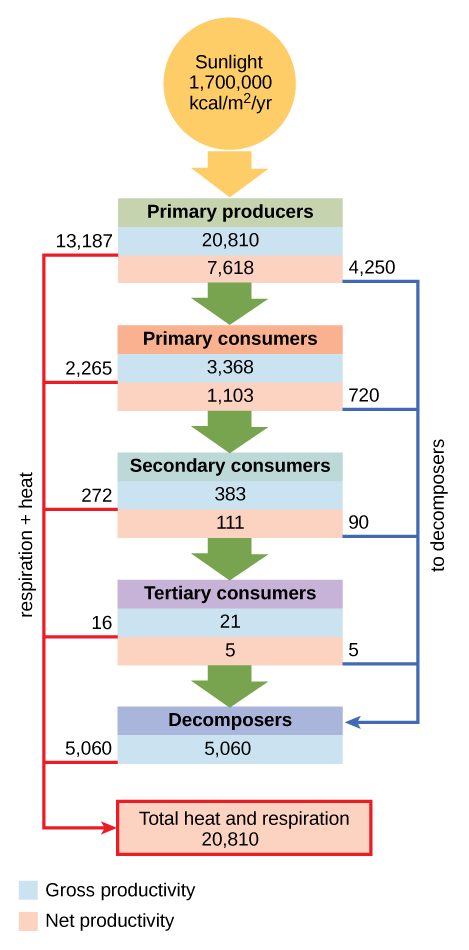| << Chapter < Page | Chapter >> Page > |
The general term "production" refers to the amount of new organic matter generated by photosynthesis. Biologists have found it useful to define and measure production more precisely. The total amount of solar energy captured by photosynthesis is gross primary productivity or GPP. Producers can use some of this energy for their own maintenance and metabolism, and also use some to produce organic compounds that they accumulate. This latter fraction is called net primary productivity or NPP. This is the only energy, contained in the biomass of the producers, that is available to all the heterotrophic organisms in that ecosystem.
Studies on both natural and agricultural systems have shown that plants capture and convert about 1.3 - 1.6% of the solar energy that is available. They use about a quarter of that captured energy for their own metabolism and maintenance, leaving only about 1% of the solar energy as net primary productivity. The standard unit for measuring productivity is grams of biomass per square meter per year, but it is important to remember that this biomass is actually converted to energy by the heterotrophic organisms. Productivity in various ecosystems ranges from approximately 2,000 g/m 2 /yr in tropical forests, salt marches, etc., to less than 100 g/m 2 /yr in some desert ecosystems. An example of gross primary productivity is shown in the compartment diagram of energy flow within the Silver Springs aquatic ecosystem ( [link] ). In this ecosystem, the total energy accumulated by the primary producers (gross primary productivity) was shown to be 20,810 kcal/m 2 /yr.
Trophic levels in an aquatic ecosystem

The structure of ecosystems can be visualized with ecological pyramids, which were first described by the pioneering studies of Charles Elton in the 1920s. Ecological pyramids show the relative amounts of various parameters (such as number of organisms, energy, and biomass) across trophic levels.
Pyramids of numbers can be either upright or inverted, depending on the ecosystem. As shown in [link] , typical grassland during the summer has a base of many plants and the numbers of organisms decrease at each trophic level. However, during the summer in a temperate forest, the base of the pyramid consists of few trees compared with the number of primary consumers, mostly insects. Because trees are large, they have great photosynthetic capability, and dominate other plants in this ecosystem to obtain sunlight. Even in smaller numbers, primary producers in forests are still capable of supporting other trophic levels.
Another way to visualize ecosystem structure is with pyramids of biomass. This pyramid measures the amount of energy converted into living tissue at the different trophic levels. Using the Silver Springs ecosystem example, these data exhibit an upright biomass pyramid ( [link] ), whereas the pyramid from the English Channel example is inverted. The plants (primary producers) of the Silver Springs ecosystem make up a large percentage of the biomass found there. However, the phytoplankton in the English Channel example make up less biomass than the primary consumers, the zooplankton. As with inverted pyramids of numbers, this inverted pyramid is not due to a lack of productivity from the primary producers, but results from the high turnover rate of the phytoplankton. The phytoplankton are consumed rapidly by the primary consumers, thus, minimizing their biomass at any particular point in time. However, phytoplankton reproduce quickly, thus they are able to support the rest of the ecosystem.

Notification Switch
Would you like to follow the 'Principles of biology' conversation and receive update notifications?